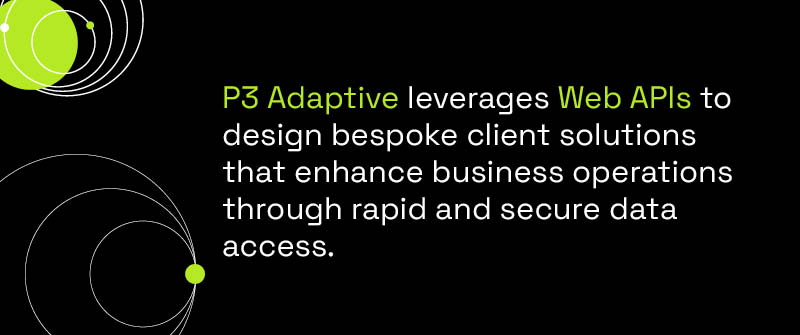
Understanding the difference between data integration and API integration empowers businesses to better harness their data assets, streamline operations, and enhance real-time communication between systems. While both involve connecting different platforms, their purposes and methods are distinct—and knowing when to use each can significantly impact your digital strategy.
In this article, we’ll break down:
- What data integration really means (and why it’s more than syncing systems)
- How API integrations work in real time to eliminate manual effort
- Where they overlap—and how they’re different
- How system integration and Web APIs fit into the picture
- When and why your business should use one over the other (or both)
Let’s explore how each approach supports smarter business decisions—and how P3 Adaptive helps companies leverage both to their full advantage.
What Is Data Integration?
Data integration is the practice of consolidating data from various sources into a unified, coherent data system. The data integration method consolidates data from various sources to create a unified dataset, thereby supporting better decision-making and analysis. Data integration platforms play a crucial role in ensuring data quality and streamlining processes such as ETL, which are essential for managing complex data integration tasks. Its objective is to ensure that all data, irrespective of its source, is accessible and consistent across the organization. High data quality is essential for accurate analysis and informed decision-making. This process is crucial in building robust databases and ensuring data-driven decision-making. Data integration also helps eliminate data silos, enhancing overall business performance and decision-making. Common data integration tools include ETL (Extract, Transform, Load) processes, which move data from multiple sources into a data warehouse.
What Is API Integration?
On the other hand, API integration involves connecting different systems via application programming interfaces (APIs) to allow them to communicate. APIs facilitate the exchange of data and functionalities between systems in real-time, enabling seamless interconnectivity. This real-time communication and synchronization between applications are crucial for efficient workflows. Additionally, API integrations help eliminate manual data entry by automating the exchange of information between multiple data sources. For example, a business could use API integration examples to connect its CRM with marketing platforms, allowing synergies that enhance operational efficiency.

Do APIs Count as Integrations? (Not Quite—Here’s Why)
It’s a common misconception: many assume that an API is an integration. In reality, while an API—short for Application Programming Interface—plays a critical role in enabling communication between different software applications, it doesn’t constitute an integration on its own.
Think of an API as the messenger. It delivers requests and responses between systems, allowing for the real-time exchange of data and functionalities. But it stops short of doing the deeper work of integrating—like consolidating, cleansing, or harmonizing data across platforms.
True integration involves more than just connectivity. It’s about creating a seamless flow of information across systems, where data is not only transferred but made usable in context. That might mean combining multiple APIs, syncing disparate data sources, and transforming raw inputs into a unified source of truth for analysis and decision-making.
This is where API integration fits in as a piece of the puzzle. API integrations support data integration by enabling real-time communication and automation between applications—but they don’t replace the need for robust data infrastructure. A strategic integration approach uses APIs as building blocks to create intelligent, interconnected systems that reduce silos and increase efficiency.
At P3 Adaptive, we specialize in architecting these kinds of solutions. We don’t just connect tools—we ensure that each API is purposefully leveraged within a broader data strategy, enabling your systems to not only talk, but collaborate in ways that drive real business outcomes.
What Is The Difference Between System Integration And API?
The landscape of business technology is vast and complex, where system integration and APIs serve pivotal roles, each with distinct functionalities and applications. Understanding these differences is essential for businesses aiming to enhance efficiency, connectivity, and agility in their IT ecosystems. Organizations often choose between cloud-based and on-premise approaches for application and data integration based on their specific needs and security considerations.
When discussing integration vs data, it’s important to note the unique benefits and challenges of each method. Application integration focuses on seamless data flow between apps, while data integration consolidates information from various sources to create a unified view, crucial for informed decision-making, enhanced analytics, and overall operational efficiency.
Cloud vs. On-Prem Considerations
As organizations increasingly shift toward digital transformation, the choice between cloud-native and on-premise integration tools plays a critical role in shaping their data strategy. Modern data integration platforms like Snowflake, Fivetran, and Stitch are built for the cloud—offering scalability, elasticity, and simplified maintenance that traditional on-premise systems struggle to match. These tools enable faster deployment, real-time syncing, and seamless connectivity with other SaaS platforms. While on-premise solutions may offer greater control and security for highly regulated industries, they often require significant infrastructure management and upfront investment. Choosing the right approach depends on your organization’s needs, compliance landscape, and appetite for agility.
Understanding System Integration
System integration involves combining different components or systems into a cohesive whole, ensuring they function together seamlessly. This integration can encompass hardware, software, networks, and even data stores. However, integrating legacy systems presents technical issues and security vulnerabilities that need to be addressed. The central aim of system integration is to increase system interoperability, enabling disparate systems to work in harmony. Implementing data integration is crucial to address these technical challenges, ensure data security, and manage large volumes of information effectively. Techniques can include middleware solutions, data transformation tools, and enterprise service buses, which facilitate communication and functionality exchange between various systems.

APIs: A More Focused Approach
An API, or Application Programming Interface, provides a set of rules and protocols for building software and applications. APIs allow different programs to communicate with one another, often over the internet, to make requests and send responses. Unlike full-fledged system integration, APIs typically focus on specific interaction points and tasks, like retrieving data from a database or triggering a process in another software application. This modularity is one of the reasons APIs have gained significant traction, offering flexibility, scalability, and ease of deployment.
What Is The Difference Between Web API And Integration?
Understanding Web API: The Gateway to Interconnected Services
A Web API, or Application Programming Interface, plays a pivotal role in enabling applications to communicate with one another across the web. It is a set of protocols and tools for building software and applications, allowing different software systems to access each other’s data and functions securely and efficiently. Web APIs are commonly used in building cloud-based applications, offering flexible data exchange and a streamlined connection between disparate systems.
Distinguishing Web API from General Integration Practices
While both Web APIs and integration aim to bridge gaps between systems, they do so in different ways. Integration is a broader concept that involves combining multiple computing systems and software applications, often through interfaces like APIs. Unlike a typical integration, which might involve batching and file exchanges, Web APIs focus on real-time, individual data exchanges over the Internet.
Integrations generally aim at creating a continuous flow of data across systems, often involving complex middleware solutions to ensure seamless data communication. In contrast, APIs specifically simplify the interaction with software components through standard operations such as GET, POST, PUT, and DELETE, allowing for an efficient way to build interconnected applications that can quickly respond to user interactions and demands.
How P3 Adaptive Helps: Strategic Integration with APIs and Data
At P3 Adaptive, we don’t just connect systems—we help businesses unlock the full potential of their data. Through strategic integration of APIs, data pipelines, and system architectures, we design tailored solutions that align with each client’s goals.
Using advanced data integration tools, we harmonize information from disparate sources to create unified, actionable datasets. Simultaneously, we implement sophisticated API integration techniques to eliminate manual processes and enable real-time data flow between platforms—transforming disconnected systems into a cohesive digital ecosystem.

Whether it’s integrating multiple SaaS tools, enhancing workflows through Web APIs, or designing secure, scalable infrastructure, our approach ensures agility, visibility, and operational efficiency. We bridge the gap between data and action—so your business can make faster, smarter decisions.
Our team brings strategic precision to every project, whether you need to connect legacy systems, implement cloud-based integrations, or build modular API solutions without overhauling your entire infrastructure. The result? A flexible, future-ready system architecture designed for growth, clarity, and performance.
With P3 Adaptive, your data doesn’t just move—it works.
Get in touch with a P3 team member